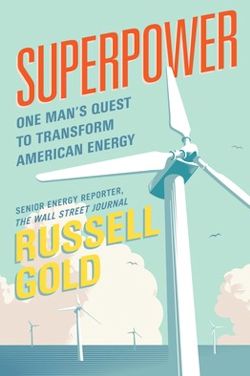SEJournal Online is the digital news magazine of the Society of Environmental Journalists. Learn more about SEJournal Online, including submission, subscription and advertising information.
BookShelf: “Superpower: One Man’s Quest to Transform American Energy”
By Russell Gold
Simon & Schuster, $27.00
 |
Reviewed by Jennifer Weeks
Over the past 15 years, the price of wind energy has fallen sharply and solar power is following the same curve now. If you’re concerned about climate change, that trend is good news.
But as the United States continues its transition away from fossil fuels in favor of cleaner energy sources, there’s much more to getting power onto the national grid than just generating it at a competitive price.
Russell Gold’s new book, “Superpower,” follows a decade of effort by Michael Skelly and his company, Clean Line Energy, to build long-distance transmission lines that could move wind-generated electricity from the Oklahoma panhandle to markets in the East and Midwest.
It’s an illuminating look into the politics and economics of energy development, and at the people who get involved in it.
Balkanized power grid
Skelly is an infrastructure developer who first got involved with wind power in 2000, when it was still a tiny industry.
He understood early on the United States didn’t have a national power grid; it had a system that was balkanized into states and counties, and was poorly suited for moving electricity over long distances.
That was a problem for renewable energy, because many of the best regions for generating wind and solar were far from high-demand centers.
Gold, an investigative reporter at The Wall Street Journal, compares the U.S. power grid to our nation’s pre-interstate highway system: “Electrons … cannot travel far without encountering congestion,” he writes. “And while the grid delivers light into every corner of the country, the electrons often must take inefficient roads to get there.”
Some states have cracked this code — notably Texas, which invested in high-voltage transmission lines to connect its windy western zones with its large cities well before much wind development had happened in the West.
Those investments have paid off handsomely for the state, which is now one of the nation’s top wind power producers.
But moving power across multiple states is harder.
Skelly envisioned building high-voltage direct current transmission lines, which he described as “renewable energy pipelines,” to move renewable power over hundreds of miles.
Running a regulatory marathon
Much of this book is about years of work that Clean Line Energy devoted to winning federal and state approval for what it called the Plains & Eastern transmission line, which was to run more than 700 miles from western Oklahoma to Memphis.
It’s a regulatory marathon that involves convincing the Tennessee Valley Authority, or TVA, to buy a significant chunk of power and then winning regulatory approval for the transmission line from authorities in Oklahoma, Arkansas and Tennessee.
‘The sooner we begin to build a new grid
to bind us together more effectively,
the more of a fighting chance we’ll have to slow, and
ultimately reverse, the carnage created by changing climate.’
— Author Russell Gold
Clean Line also has to convince the U.S. Department of Energy to partner with it under an untested provision of the Energy Policy Act of 2005, which would include the federal power of eminent domain to take land for use deemed to convey clear public benefit.
Skelly and his colleagues, however, didn’t want to use eminent domain if they could avoid it. Every employee in the company had to participate in public meetings in communities where they were seeking to secure development rights.
One reviewer commissioned by the Energy Department was “astounded” by the number of meetings that Clean Line held during its environmental review — far beyond the number required by law. The company also accepted many conditions from the department and offered numerous concessions to TVA in an effort to win its business.
Many of these adjustments stretched out the time required to get to decisions, driving up the project’s costs.
Spoiler alert: The project gets close to a green light, but ultimately fails when TVA opts not to buy power transmitted by Clean Line, even at a spectacularly low price.
TVA President Bill Johnson later refuses to show Gold any of its analyses, which will probably never become public because no regulator oversees TVA’s decisions.
Gold compares Clean Line’s experience to Cape Wind, the first offshore wind power project proposed in the United States, which was stalled by a wall of political opposition until the company’s agreement to sell power expired.
Now, however, another company has turbines running not far from Cape Wind’s proposed site, and more offshore wind projects are in the planning stages.
“Clean Line showed what could be done. It is up to others to walk through that door,” Gold writes. “The sooner we begin to build a new grid to bind us together more effectively, the more of a fighting chance we’ll have to slow, and ultimately reverse, the carnage created by changing climate.”
Jennifer Weeks is environment and energy editor at The Conversation U.S., based in Boston, a former SEJ board member and a regular contributor to SEJournal Online BookShelf.
* From the weekly news magazine SEJournal Online, Vol. 4, No. 31. Content from each new issue of SEJournal Online is available to the public via the SEJournal Online main page. Subscribe to the e-newsletter here. And see past issues of the SEJournal archived here.














 Advertisement
Advertisement 




